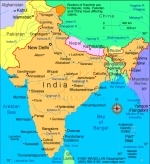by
Robert Garment, Executive Editor | March 24, 2006

India plans to make
the rupee convertible,
encouraging more
foreign investment
The rupee is about to roar. And it should be a sweet sound to many DOTmed users.
Prime Minister Manmohan Singh has indicated his government's readiness to move towards capital account convertibility -- making the flow of money in and out of the country easier. The central bank announced the appointment of a six-person committee to produce a "road map" toward that goal by July 31, 2006.
India first drew up plans to make its currency fully convertible 10 years ago, but abandoned them after several East Asian countries were hit by a financial crisis.



Ad Statistics
Times Displayed: 1227
Times Visited: 6 Fast-moving cardiac structures have a big impact on imaging. Fujifilm’s SCENARIA View premium performance CT brings solutions to address motion in Coronary CTA while delivering unique dose saving and workflow increasing benefits.

Mahatma Gandhi has reason to smile, as the rupee
will soon be flexing new muscle
As the Indian economy booms, the government says the time is right to take a fresh look at relaxing all controls on the rupee.
Financial analysts agree. India's foreign exchange reserves top more than $140 billion. The rupee has been stable and the past two years have seen a surge of interest in India among foreign businesses.
Abheek Barua, chief economist at ABN Amro Bank in Bombay, says lifting controls on the currency will enable India to get more foreign investment to maintain high growth.
This new expansion of India's already robust economy should lead to a strong increase in sales for both new and used medical equipment. DOTmed users should start to develop strategies to take advantage of this potential -- for instance, getting familiar with India's customs regulations. The other good news is that the convertibility of the rupee will make it far easier to transfer money out of India, in effect, greasing the skids for used medical equipment dealers.
Right now the rupee can only be freely converted for trade in goods and services. Other types of foreign investments, such as acquiring overseas assets, must be approved by the central bank. This will all change when the currency is fully convertible.
This change-over would come in conjunction with initial steps toward lifting restrictions on foreign investment in Special Economic Zones (SEZ), as part of India's drive to promote investment for upgrading its infrastructure. More money would help address bottlenecks in facilities including roads and ports, a much-cited constraint upon the productivity of the Indian economy.
Lawrence Summers, the president of Harvard University in the U.S., recently visited India. The former U.S. treasury secretary said the move is inevitable if India wants to become an economic powerhouse.
"Ultimate successful integration with the global economy will require capital account convertibility, so on a success scenario for India the question is not if, the question is when," he says.
Indian central bank officials have cautioned the government to keep inflation low and its fiscal deficit in check if it wants to make the rupee fully exchangeable.
The ambitious step is being described as the country's biggest economic development since sweeping reforms of its socialist-style economy in 1991 helped usher in an era of high growth.


